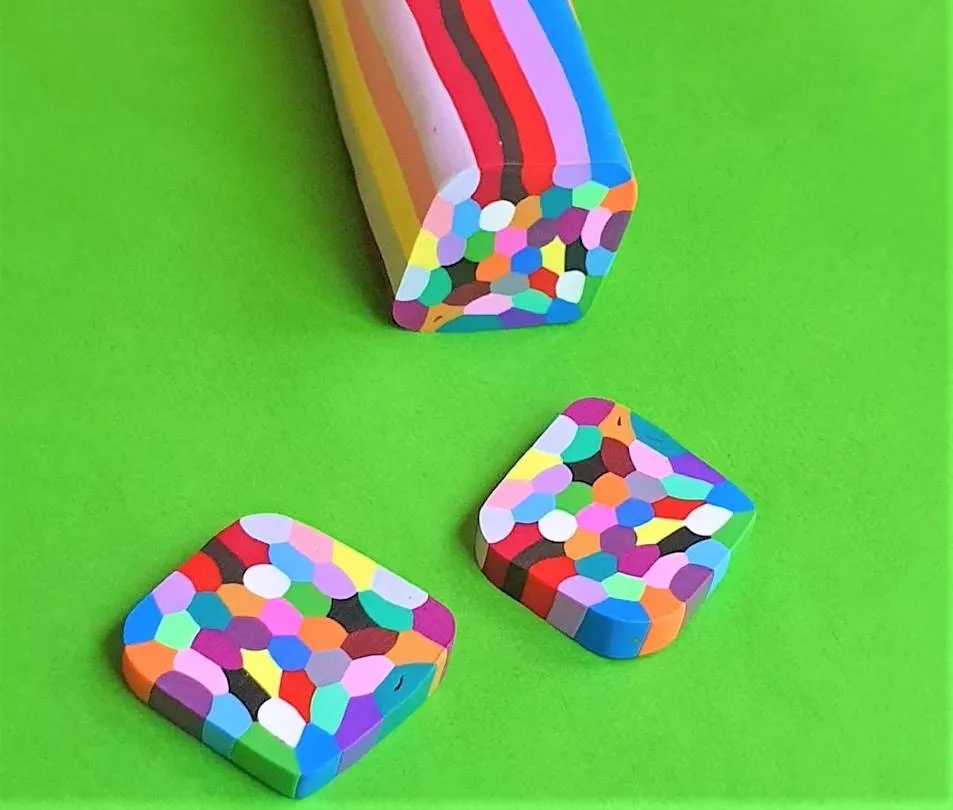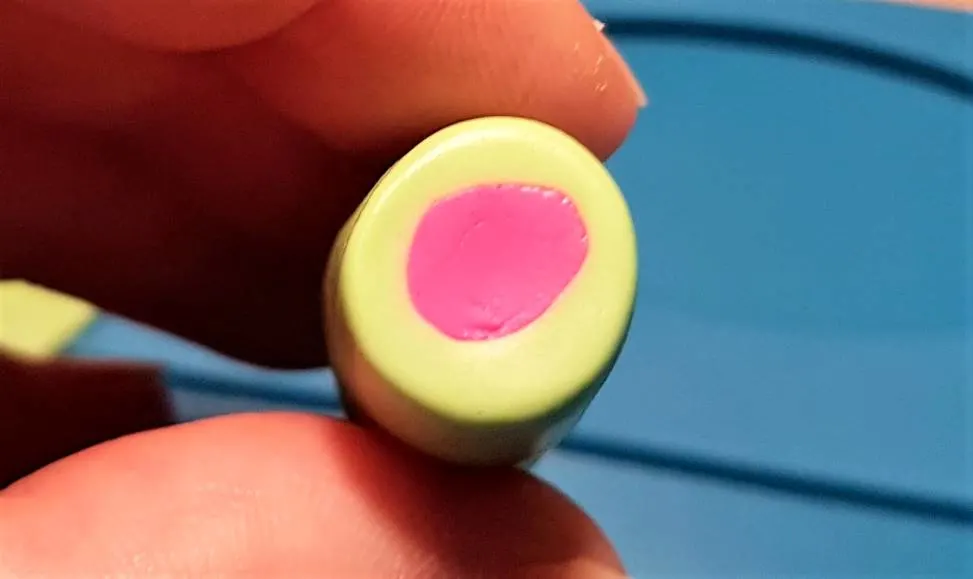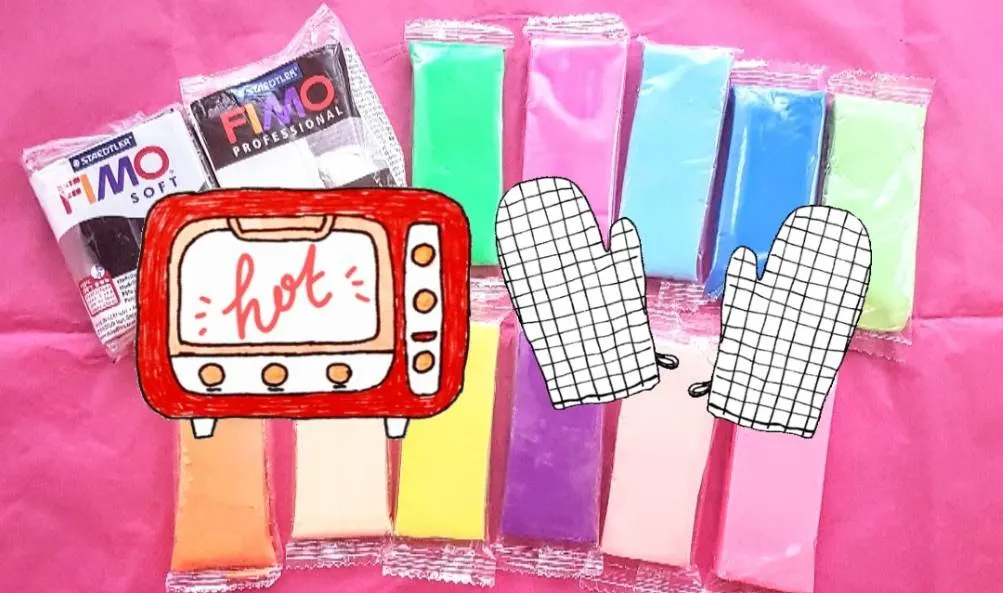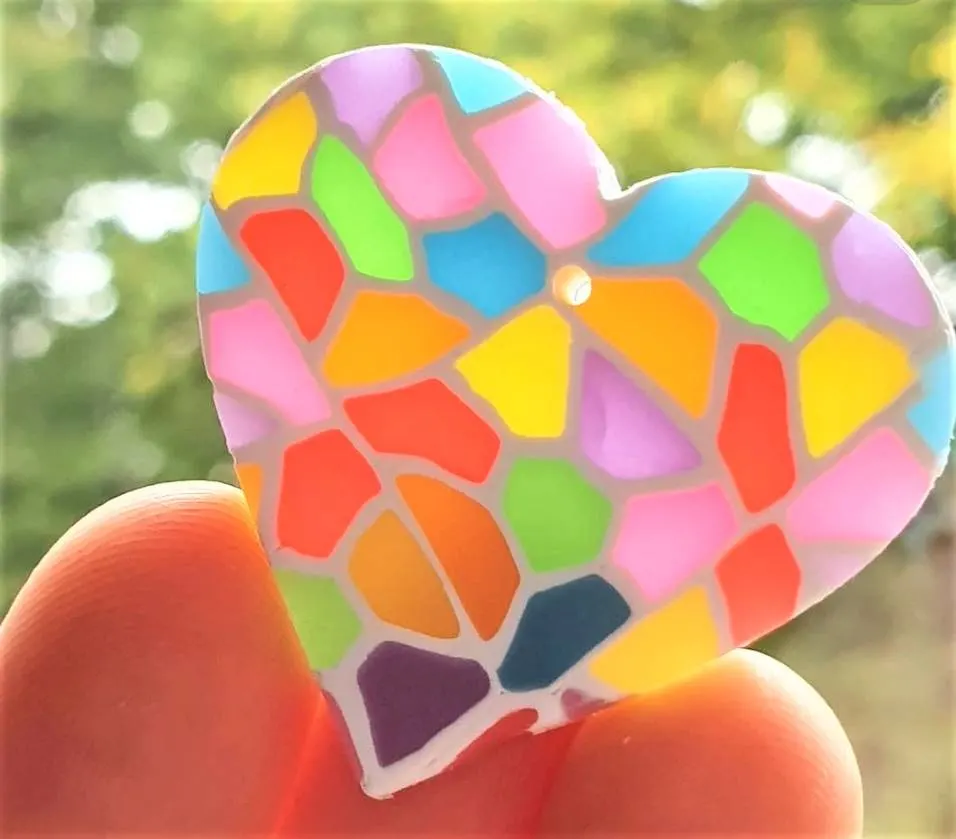Polymer clay is a popular crafting material that is everywhere at the moment; on our Instagram feeds and in our YouTube recommendations alike. If you’re familiar with this craft, you may have heard of clay caning, and be wondering what exactly it is?
Read on for my guide to polymer clay canes, including some design ideas and tips to help you get going if you want to make your own, or recommendations if you would like to buy ready-made canes online…
This post may link to online stores. If you click a link and buy something, I may get a commission. Learn more.
What is a Polymer Clay Cane?
A polymer clay cane is a rolled stick of clay similar to a candy cane, or canes of glass used in traditional glass working. The cane of clay features a central design, that runs throughout the entire stick, that when cut into pieces will feature an identical pattern. Canes are particularly useful for polymer clay jewellery making, as they make uniformed designs easier to achieve.
Slicing designs from a cane of clay is a quick way of mass producing earring designs, such as studs, as one long stick has a high yield. The concept of caning is used in many other crafts, such as glasswork or candy making, as a beautiful way of creating mass uniformed designs.
There are countless designs of polymer clay canes that can be bought or made at home; the caning technique will really elevate your polymer clay jewellery game, and is also useful for model making and other polymer clay crafts. Some of the most beautiful polymer clay earrings I’ve come across have been made using the caning technique, and some of the designs are simply breath-taking – there are a lot of talented people out there!
Why not have a go at caning for yourself, or buy some canes to add to your collection, for quick jewellery making and other crafts.
Polymer Clay Cane Designs and Patterns

Easy Polymer Clay Canes
There are countless polymer clay cane designs and patterns out there, but there are a few staple techniques that you will come across again and again.
Checkerboard, bullseye, striped and jellyroll are the basic beginner’s styles of canes that you should learn to create first. Many more complicated cane designs are actually just made up of multiples of these rolls, to form new patterns. Once you’ve mastered the basics you can use those skills to take on the more complicated polymer clay cane projects.
Advanced cane designs
More complicated canes come in just about any design you can think of, from flowers, leaves, butterflies, cute animals, funny faces to geometric patterns, kaleidoscopes, retro patterns granny square blanket and more.
Once you’ve mastered the basics get creative and see what you come up with; there are a whole host of cane making ideas on YouTube sure to provide you with inspiration!
What are Polymer Clay Canes Used For?
Polymer clay canes are used for a variety of projects, from jewellery making to Christmas decorations and models. They’re a quick and beautiful way to add a lot of uniformed detail to a project, and can really elevate your clay game with a chic and professional touch.
They’re impressive to look at and make for lovely earrings, which I’m going to be delving into a bit more here.
Here are some ideas of how to use canes in jewellery making:
- As studs – you could get really creative here and produce some lovely little studs very quickly
- As drop earrings, and tiered drop earrings – use three slices of your cane to do a three tiered drop earring with jump hoops
- Add cane cuttings onto a thin roll of clay, then slice and bend in a circular fashion to create clay hoops with cane details – there are loads of cane hoop ideas on google!
- Add cane slices to a slab of clay for use with clay cutters, for an intricate slab design
- Poke a hole through a slice from a clay cane to form a bead
Where to buy Polymer Clay Canes?
If you don’t want to make your canes yourself there are loads available to buy ready made online.
Premade canes are perfect for the following reasons:
- Time saving, on learning how to cane and going through the process
- Cost saving on buying differently coloured blocks of clay
- A professional finish, with uniform designs to add to your projects quickly and easily
There are some very talented creators who post their canes for sale on Etsy, or if you want to buy a batch of ready made designs, you can do so fairly cheaply on Amazon.
I’ve included a couple of ready-made cane recommendations below, with some adorable designs that I think would look great added to earrings!
This is a great bunch of versatile canes, with loads of designs to pick from, made from FIMO clay – my favourite brand for cane making.
Cute 3D Fimo canes:

These are also some really cute Christmas design canes that would be great for festive earrings!
Pandahall canes:

How to Make Polymer Clay Canes – instructions?
My favourite clay to use for making canes is FIMO, as it’s consistency is perfect – not too hard, not too soft. You want to avoid softer clays for cane making, like Sculpey, as they will be too squishy to work with.
Check out my guide to clay for jewellery making here:
Here is a guide to making a simple bullseye cane, so you can get your head around how caning works.
How to Make a Bullseye Polymer Clay Cane

What you will need:
- Two colours of your clay brand of choice
- A clay blade
- An acrylic rolling pin or pasta machine
Method:
- Take the clay you would like to use for the external colour of the bullseye cane and roll it into a sheet, about 0.5 cm thick. Trim off the edges so it looks like a rectangle with clean lines.
- Roll a cylindrical stick of your second colour. Place this at the end of your sheet, vertical to the shortest side of the rectangle and trim the sheet to the correct length of the cylinder.


- Begin to roll the sheet of external clay around it, a bit like making a sushi roll, where the internal colour is the rice and the external is the seaweed sheet.
- Roll until the cylinder is covered, and then trim off the excess of the external sheet.


- Roll the seam against your working mat to seal the cane.


- Then start to squish/reduce the cane by stretching it out to make it longer. Take your time with this until the cane looks even.
- Then roll the cane with your hands over the mat to even it out.
- Then cut your cane into even slices, and there you have your designs!
Here are all of the steps once more in one image for you:








Now you have you polymer clay cane ready, you can go ahead and slice it with a clay cutting tool into as many pieces as you wish. You can make the cane as long or short as you would like, depending on the size of your project.
Once your slices are cut, it’s time to bake them…
Baking tips:

Here’s an A-Z break down of individual brands and their baking time, so you have a comprehensive quick guide to hand:
Cernit: 30 minutes between 110 and 130°C (230-266°F)
Fimo: Maximum of 30 minutes at 110°C (230°F)
Kato Polyclay: 10-30 minutes at 150°C (300°F)
Original Sculpey: 15 minutes per quarter inch (6mm) of thickness at 130°C (275°F)
Pardo Art Clay: Min 30 minutes at 120 decrees (248 F)
Pardo Translucent Jewellery clay: Min 30 minutes at 120°C (248°F)
Premo: 30 minutes per quarter inch (6mm) of thickness. If thicker, initially bake for 15 minutes and then add another 5 minutes, another 5, and so on until done.
PVClay: 15-20 minutes at 130°C (275°F)
Sculpey III: 15 minutes per quarter inch (6mm) of thickness at 130°C (275°F)
Sculpey Souffle: 30 minutes per quarter inch (6mm) of thickness at 130°C (275°F)
Super Sculpey: 15 minutes per quarter inch (6mm) of thickness at 130°C (275°F)
Slice your cane first before baking, and either add your jewellery hook holes then, or drill the holes in afterwards once the clay has sufficiently cooled.
How to Store Polymer Clay Canes?
Storing polymer clay canes is simple, stack them so they are upright and the canes do not touch each other and cause sticking and colour transfer. Storing them upright allows you to see the design of the cane right away, when searching for a design to use, instead of riffling through rows of canes laid flat.
You can separate canes by wrapping them in clingfilm, and you can even store them in your freezer for years at a time. Colder conditions help the clay last longer.
For storage I would recommend a glass or a plastic box – a glass container is great as the base of the cane will stick to glass, propping it up for you.
If you would like to use plastic unbaked polymer clay should be stored in either it’s plastic wrappings, cling film, a zip-clocked or sandwich bag, a plastic storage box or storage drawers made from polypropylene (PP) plastic.
Also, the containers don’t need to be completely air tight, as clay won’t air dry or dry out, which is one of the reasons it’s so easy to keep and use.
Top tip: to tell if something is the correct plastic, flip it over and look for the markings on the bottom. There should be the number five in a triangle on the underside.
PLEASE NOTE –
It’s not advised that you store baked and unbaked clay together, as the uncured components of the unbaked clay may actually weaken the baked clay over time, through exposure to it’s oily residue.
This is due to what the clay is made of and how it responds to baking; the clay is made up of plastics, stabilizers, fibres and colouring components, that can be quite greasy before baking. Once exposed to the proper temperature for the allotted time, the clay hardens up and the oily residue solidifies. If you then place that hardened clay next to unbaked clay, the residue in the unbaked clay can draw back into the porous baked clay and start to make it brittle.
Keep your clay stored away from sunlight, as prolonged expose to the sun will not only melt your clay but also cause your clay to fade due to sun bleaching, ruining the lovely vibrancy of your cane.
Related Questions
Will Polymer Clay Dry Out?
Polymer will not dry out at room temperature. Polymer clay requires oven baking in order to properly dry and harden, at the temperature suggested on the packaging of each individual brand, and so will not dry out in a normal room, in normal conditions.
Is Polymer Clay Toxic?
Polymer clay is non-toxic, making it safe to use around children and pets, as it has been tested and certified. Polymer Clay only becomes toxic when baked at extremely high temperatures, for prolonged periods of time. If baked according to the packaging instructions, it’s perfectly safe.
Read more here:
Will Polymer Clay Air Dry?
Polymer Clay cannot air dry, it needs to be oven baked at the correct temperature for the brand you are using; instructions are found on the packaging of each clay block. Oven baking allows the clay to sufficiently cure (harden) which cannot be achieved at room temperature with air drying.
Can Polymer Clay Get Wet?
Both baked and unbaked polymer clay is waterproof as the material is oil based (made with plastics), so it cannot get wet.
Read more here:
Conclusion
I hope you enjoyed my guide to polymer clay canes and you now have a good understanding of what these crafty little creations can be used for, particularly in jewellery making. This technique is a wonderful hack to master and will ensure you have uniformed intricate designs to add to your slabs, make studs from or press together to form even more complicated canes – the possibilities are endless!
My goal is to make the world of polymer clay earring making easy, accessible and fun for everyone looking to get started in this rewarding and versatile craft; I hope you come to love it as much as I do.
To make life easier for you I have created as many guides as I could possibly think of on polymer clay, to ensure as much help info is out there for beginners as possible. Check out some of my other articles if you’d like to learn more and level up your skills…
I also provide articles on: a How-to Guide for beginners, a Sales Guide for selling polymer clay earrings on Etsy, a comprehensive Cost Guide, and a bumper list of earring Design Ideas, so you’re never stumped by clay-makers block!
For more information on getting started with polymer clay earrings, check out:
How Much does it Cost to Make Polymer Clay Earrings?
Can You Paint Polymer Clay Earrings? A How-to Guide
How Long to Bake Polymer Clay Earrings – Quick Guide
How to Sell Polymer Clay Earrings on Etsy
How to Make Polymer Clay Earrings: the Basics
Design Ideas for Polymer Clay Earrings
Top Tips for Making Polymer Clay Earrings
Why Polymer Clay Breaks and How to Fix it
The Best Polymer Clay for Earrings and Other Jewellery

Lorna is a footwear geek and the founder of Wearably Weird. She created a YouTube channel in 2021 for fellow footwear fanatics, dedicated to detail-rich footwear reviews and info. She has a fashion media qualification (awarded in 2011).

